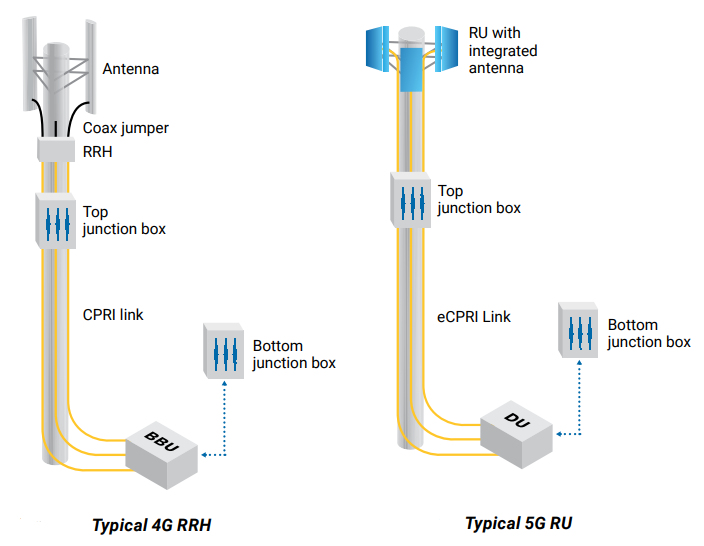4G cell sites
4G remote radio heads (RRHs) are typically mounted at the top of cell towers or on building rooftops. The ability to cover a large geographic area using radio frequencies in the sub‑3 GHz spectrum was ideal for these installations. A single sector would consist of an RRH connected through a small form-factor pluggable (SFP) device to a single CPRI link using an optical cable between the RRH and another SFP in the BBU. A short, co-axial jumper cable connects the RF output ports on the RRH to the antenna.
A single cell site might cover a range of about 10 km.
The split of the RRH and BBU functions allowed high loss coaxial cable running up the towers to be eliminated, reducing amplifier power requirements, which in turn led to smaller HVAC and backup power requirements.
However, the lack of a contiguous spectrum around 4G frequency bands limits the amount of bandwidth that can be offered to the end-user.

5G cell sites
In 5G two frequency ranges are offered, FR1 (450-7125 MHz) and FR2 (24250-52600 MHz). The FR1 frequencies offer channel bandwidths of up to 100 MHz depending on the operator’s spectrum holding while FR2 frequencies—referred to as millimeter wave (mmWave)—are in a less crowded area of the frequency spectrum and allow channel bandwidths of up to 400 MHz.
The higher the channel bandwidth, the greater the potential throughput of the cell.
However, the higher the frequency the shorter the distance the RF signal will travel. So 5G cells using mmWave will see densification in the number of cell sites required to cover the same geographic area. This densification is also required to support the higher capacity for the number of connected devices offered by 5G.
RUs using mmWave are typically mounted on street lamps, utility poles, or the sides of buildings. This is due to the relatively short distances that mmWave can support. A single site might cover a range of only a few hundred feet.
In many 5G, RU’s the antenna will be integrated into the RU. This is due to massive MIMO and the mmWave frequencies that form part of 5G.
5G cells using mmWave will see a densification in the number of cell sites required to cover the same geographic area.
Source: EXFO The Evolution of 5G, White Paper
